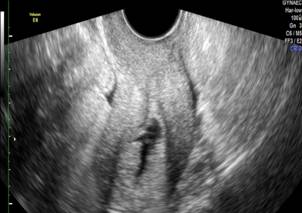Role of saline infusion sonography in patients with infertility and comparison of the same with transvaginal ultrasonography
Abstract
Introduction: Transvaginal scan is considered as the baseline investigation in women with infertility. Saline infusion sonography is used to study the distended uterine cavity and provides adequate visualisation of the same. This study is performed to assess the role of SIS in women with infertility and to compare its ability in identifying endometrial pathology with that of routine transvaginal sonography.
Materials and Methods: In this prospective study, we studied 20 women who attended the infertility clinic in our hospital. All were subjected to routine transvaginal scan followed by saline infusion sonography after obtaining consent for the procedure. All these 20 women also underwent diagnostic hysteroscopy for evaluation of endometrium.
Results: The findings noted with transvaginal scan and SIS were analysed and compared with hysteroscopy findings. Endometrial polyp was identified in 8 patients and rest 12 were found to have normal endometrium in Transvaginal scan. 8 women were found to have polyp, 1 with synachiae and rest 11 with normal endometrial cavity during saline infusion sonography. However hysteroscopy showed polyp in 8 and synechiae in 1. The sensitivity of SIS in identifying endometrial pathology in infertile women was better than that of TVS. Specificity remains same for both modalities. Polyps were better identified and demonstrated with SIS, however both modalities were not very efficient in identifying synachiae.
Conclusion: Saline infusion sonography, being an outpatient procedure requiring no anaesthesia and cost effective, can be used confidently to study the endometrial cavity in women with infertility as base line investigation. Those in whom abnormalities identified during the study can be taken up for invasive procedure, hysteroscopy. SIS can thus be performed as a preliminary procedure before hysteroscopy.
Downloads
References
2. Allison SJ, Horrow MM, Kim HY, Lev-Toaff AS. saline-infused sonohysterography: tips for achieving greater success. Radiographics. 2011 Nov-Dec;31(7):1991-2004. doi: 10.1148/rg.317115074. [PubMed]
3. Berridge DL, Winter TC. Saline infusion sonohysterography: technique, indications, and imaging findings. J Ultrasound Med. 2004 Jan;23(1):97-112; quiz 114-5.
4. Reddi Rani P1 , Lakshmikantha G2, TransvaginalSonography (TVS) and Saline Infusion Sonohysterography (SIS) in the Evaluation of Abnormal Uterine Bleeding (AUB), J ObstetGynecol India Vol. 60, No. 6 : November / December 2010 pg 511 – 515.
5. Nanda S, Chadha N, Sen J, Sangwan K. Transvaginal sonography and saline infusion sonohysterography in the evaluation of abnormal uterine bleeding. Aust N Z J Obstet Gynaecol. 2002 Nov;42(5):530-4. [PubMed]
6. Khan F, Jamaat S, Al-Jaroudi D. Saline infusion sonohysterography versus hysteroscopy for uterine cavity evaluation. Ann Saudi Med. 2011 Jul-Aug;31(4):387-92. doi: 10.4103/0256-4947.83213.
7. Aslam M, Ijaz L, Tariq S, et al. Comparison of Transvaginal Sonography and Saline Contrast Sonohysterography in Women with Abnormal Uterine Bleeding: Correlation with Hysteroscopy and Histopathology. International Journal of Health Sciences. 2007;1(1):17-24. [PubMed]
8. Kelekci S, Kaya E, Alan M, Alan Y, Bilge U, Mollamahmutoglu L. Comparison of transvaginal sonography, saline infusion sonography, and office hysteroscopy in reproductive-aged women with or without abnormal uterine bleeding. Fertil Steril. 2005 Sep;84(3):682-6.



 OAI - Open Archives Initiative
OAI - Open Archives Initiative


